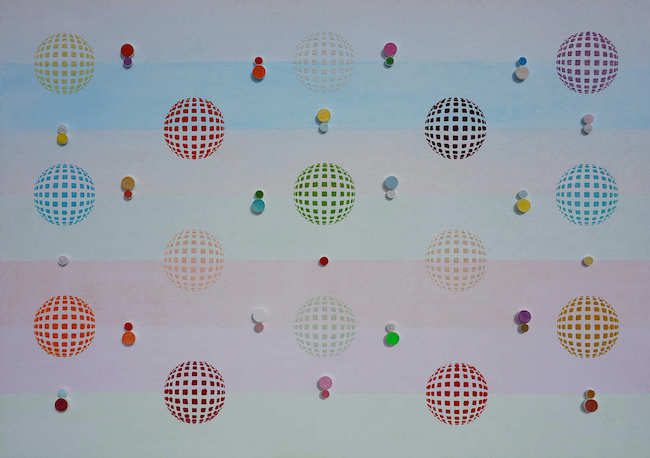Nel momento in cui tutto ciò che appartiene alla realtà osservata, e anche ciò che invece ne è diametralmente opposto e dunque indefinito, non è più sufficiente agli artisti per esprimere la propria personalità creativa, allora emerge la necessità di spostarsi verso confini completamente differenti, spesso più intellettuali che non emozionali eppure ugualmente in grado di raccontarne il punto di vista, l’approccio nei confronti di quella ricerca che diviene punto focale della loro produzione. In questo caso l’incontro con la materia dona consistenza e concretezza a quei passaggi evolutivi essenziali a trovare una forte e incisiva personalità espressiva. L’artista di cui vi racconterò oggi affronta questo tipo di percorso dando vita a opere dove il concetto riesce a entrare in maniera armonica all’interno di una mancanza di forma che però diviene amplificatrice di un messaggio sottile apparentemente invisibile eppure fortemente presente.
Il periodo più incisivo nell’arte del Ventesimo secolo fu senza dubbio quello che iniziò nel secondo ventennio e che proseguì fino agli anni Cinquanta, poiché le precedenti esperienze legate al distacco totale dalla realtà osservata, in cui era necessario sottolineare l’autonomia e la supremazia del gesto plastico dal mondo emozionale e soggettivo non solo dell’autore bensì anche del fruitore che doveva essere attratto dalla perfezione esecutiva senza provare sensazioni che non fossero quelle legate alla bellezza intrinseca dell’atto artistico, avevano in qualche modo terminato il loro corso inducendo i nuovi artisti dell’epoca a spingersi verso terreni nuovi e inesplorati. In questo contesto, e dopo aver raccolto le eredità dei movimenti più astratti, dal De Stijl olandese al Suprematismo russo, dall’Astrattismo geometrico al Razionalismo della Bauhaus, scuola quest’ultima dove cominciarono a nascere le prime interazioni tra arte e materiali appartenenti abitualmente ad altri utilizzi o applicando l’arte e strumenti apparentemente discostanti da essa, in questo contesto, dicevo, si svilupparono movimenti in cui l’assenza di forma fu estremizzata tanto quanto fu enfatizzato l’uso del colore spogliato da ogni tipo di sfumatura fino a giungere alla monocromia. Tutte le correnti che nacquero in quel periodo si spostarono verso la ricerca e l’introduzione della terza dimensione, aggiungendo, come parte del processo creativo anche il movimento; dunque lo Spazialismo estremo in cui l’atto di tagliare la tela diveniva esso stesso momento significativo dell’esecuzione dell’opera, come nella produzione di Lucio Fontana, si affiancò a una ricerca più morbida, incredibilmente intellettuale sulle infinite possibilità di dialogo con l’esterno generato dai rilievi ottenuti tramite l’utilizzo i chiodi posti al di sotto della superficie della tela che contraddistinsero il lavoro di Enrico Castellani e Agostino Bonalumi. La monocromia nelle loro opere era funzionale a dare massima rilevanza all’apertura o alle luci e ombre che derivavano da quella forma espressiva, mentre in altri casi l’intera produzione artistica si soffermò unicamente sulla purezza del colore, utilizzato sotto forma di pigmento e tenuto insieme con un fissativo particolare per trasformarne l’inconsistenza, come nel Minimalismo di Yves Klein. Il ruolo importante di questi grandi maestri del secolo scorso fu di fatto quello di mettere in evidenza l’importanza di un tipo di arte che, pur non essendo riconducibile né alla realtà osservata né al sollecitando un trasporto interiore, di fatto attraeva e conquistava il fruitore per la pura ricerca intellettuale, per quello stimolo a comprendere il processo esecutivo dell’autore, l’analisi quasi scientifico che lo aveva portato a dare origine ai suoi lavori.
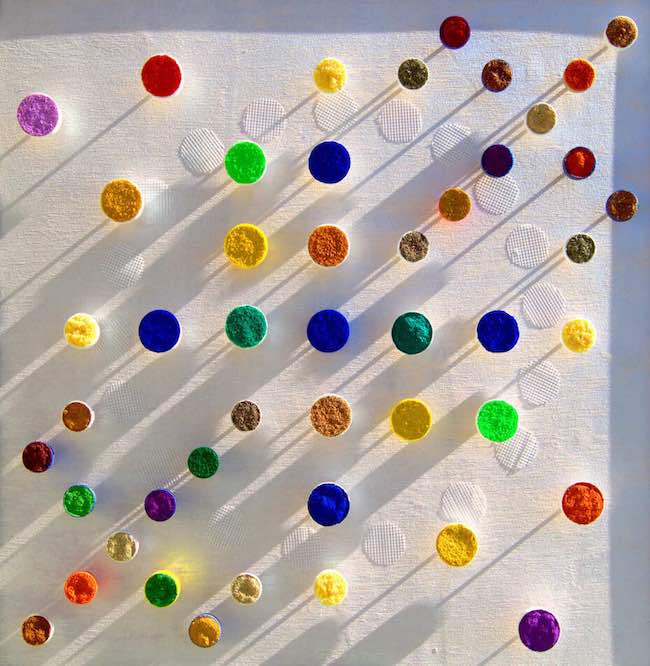
L’artista lombardo Michele Toniatti raccoglie l’eredità pioneristica degli esponenti di quegli anni di sperimentazione dando vita a una sua personale cifra stilistica dove da un lato amplia ed enfatizza l’utilizzo dei chiodi che Castellani e Bonalumi nascondevano sotto la tela e che con lui si trasformano, vengono ammorbiditi nella materia e resi sostegno visibile per i veri protagonisti di alcune delle sue opere, in cui la diversità cromatica spicca sulla neutralità dei pigmenti dello sfondo; ed è proprio sull’uso di questi ultimi che si focalizza la sua ricerca, usandoli in maniera pura e lasciando che essi divengano tappeto ideale per la vivacità coloristica che contraddistingue i suoi lavori.
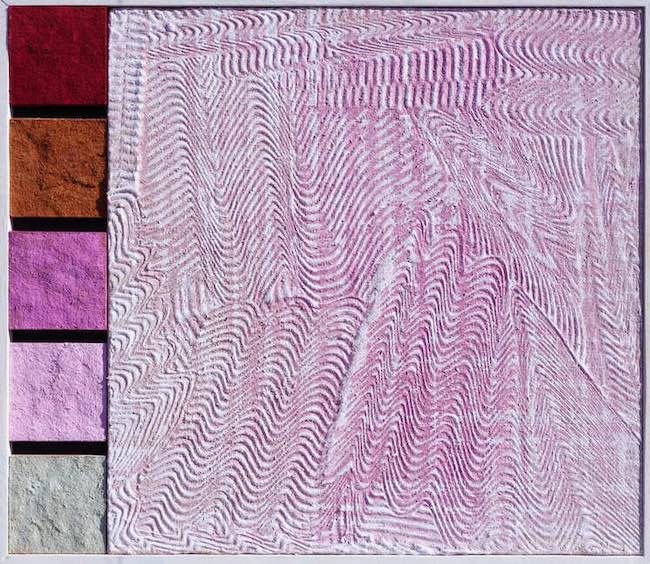
Contrariamente a Yves Klein però, Michele Toniatti non si sofferma su una sola tonalità bensì ha bisogno di mescolare, di creare sfumature che svelano l’assenza di determinismo dando spazio invece al possibilismo, a tutto ciò che non appartiene solo alla realtà bivalente bensì alle infinite sfaccettature che ogni evento, ogni circostanza, ogni punto di osservazione può presentare; non solo, l’artista attraverso le variazioni cromatiche, si assesta sulla consapevolezza delle differenze, dell’unicità di ciascuno proprio in virtù delle tonalità che lo contraddistinguono. Ecco dunque il motivo per cui oltrepassa le linee guida dei suoi predecessori rifiutando la monocromia, perché in un mondo contemporaneo tanto poliedrico e cangiante, così marcatamente costituito da un forte individualismo, malgrado poi però le persone tendano sempre a ricercare un’appartenenza, non sarebbe per lui possibile restare all’interno di un’uniformità cromatica che lo distoglierebbe dall’apertura che invece caratterizza il suo approccio alla vita.
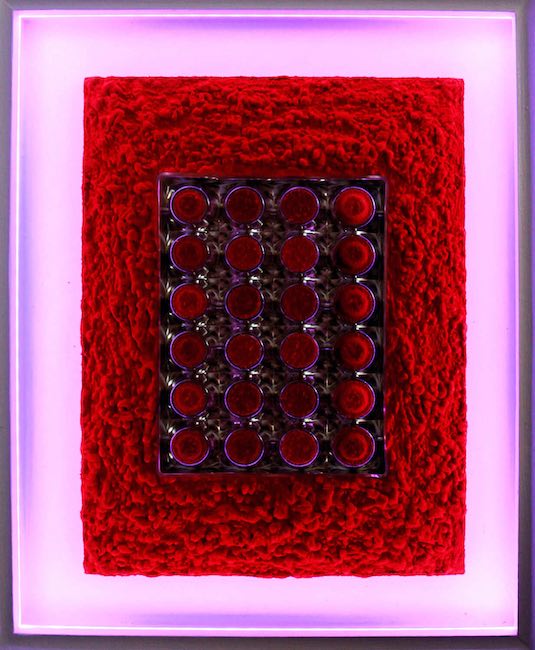

Il legno è il supporto su cui Michele Toniatti struttura le sue opere, come se la consistenza e la solidità di quel materiale fosse indispensabile per poi apporvi l’impalpabilità dei pigmenti puri che donano un’apparenza soffice, così come i sostegni dei tappi delle opere della serie Button sono meno coriacei e duri del ferro dei chiodi invece utilizzati da Castellani e da Bonalumi per le loro estroflessioni; in Button 2 emerge il concetto di diversità a dispetto della prossimità poiché Toniatti pone a distanza regolare i suoi pulsanti colorati ma poi alla base del perno che li sostiene mette una rete, quasi a voler delineare lo spazio vitale di cui l’essere umano ha bisogno per non dimenticarsi della propria vera essenza. Infatti ciascun bottone è costituito da sfumature differenti, non ce ne è uno identico all’altro, evidenziando dunque quello che è un concetto centrale della produzione dell’artista, quel caleidoscopio di esistenze che si sfiorano quotidianamente senza mai conoscersi a fondo, o forse al contrario pur conoscendosi devono in qualche modo apprendere a mantenersi saldi alla propria personalità, senza lasciarsi condizionare da influenze esterne.
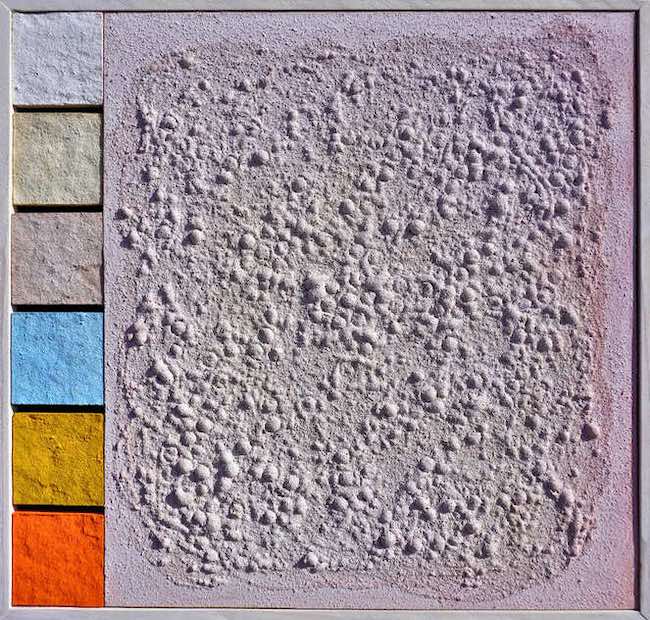
Nella serie Landescape dunque l’artista gioca con le parole poiché malgrado l’evocazione di un panorama, di fatto l’aspetto informale delle opere annulla ogni riferimento visivo, ecco perché nella seconda parte del titolo parla di fuga. La realtà deve essere interpretata sulla base della propria interiorità, della propria predisposizione e approccio all’esistenza, ma a dispetto di questa relatività sempre presente, non per questo è possibile considerare un punto di osservazione più reale rispetto a un altro, non necessariamente una tonalità più accesa predominerà sull’impatto evocativo di una più delicata e apparentemente leggera.
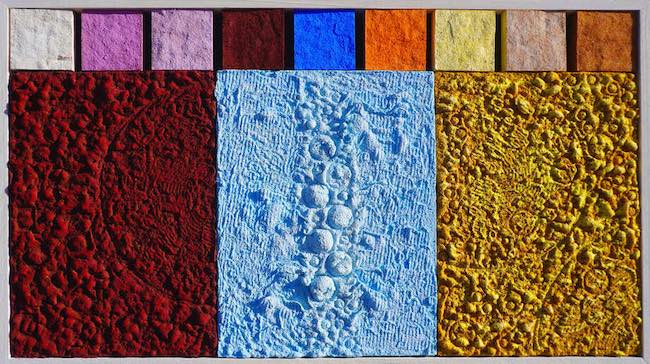
Nell’opera Landescape N.6 Michele Toniatti sperimenta differenti tecniche di apposizione dei pigmenti, affinché essi mostrino una struttura differente, fascia cromatica per fascia cromatica, quasi come volesse rappresentare molteplici fasi di un’osservazione mentale e interiore che lo ha poi condotto all’esecuzione del lavoro; le tonalità sono accattivanti, sia per quanto riguarda le tre principali che dominano la tavola, sia nelle parti più piccole dove è persino più evidente il possibilismo che appartiene all’artista. Laddove Yves Klein si era dedicato a trovare la composizione perfetta del blu, Michele Toniatti sembra voler ricercare ogni potenziale perfetta variazione di colore, lasciandosi affascinare dalla pura bellezza di tutte quelle tonalità che arricchiscono la vita attraverso la contemplazione dell’arte, come se quest’ultima fosse un mezzo indispensabile a evadere per lasciare che la mente si liberi da ogni riferimento, da ogni influenza esercitata da tutto ciò che lo sguardo conosce e a cui si aggrappa.
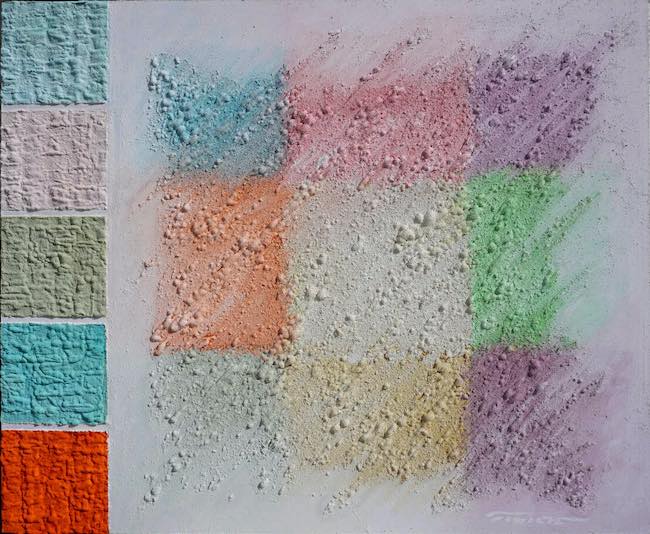
Michele Toniatti ha al suo attivo la partecipazione a moltissime mostre personali e collettive in Italia e all’estero – Parigi, Figueres, Budapest, Londra, New York, Barcellona, Bruxelles, Cannes -, nel 2018 gli è stato conferito il Premio alla Carriera presso sala stampa Camera dei Deputati a Roma, nel 2020 gli è stato consegnato a Cannes il Prix Grand Artiste in merito al progetto Congiunti edito dalla casa editrice Giunti, e infine il Premio alla Carriera assegnato dal Maco Museo di Veroli; è presente da anni nell’Atlante dell’Arte Contemporanea e nel Catalogo dell’Arte Moderna di Giorgio Mondadori.
MICHELE TONIATTI-CONTATTI
Email: micheletoniatti@gmail.com
Facebook: https://www.facebook.com/michele.toniatti.39
Instagram: https://www.instagram.com/toniattimichele/
The artistic experimentations of Michele Toniatti, between Conceptual Informalism and the immateriality of Minimalist research
At the moment in which everything that belongs to the observed reality, and also what instead is diametrically opposed to it and therefore undefined, is no longer sufficient for artists to express their creative personality, then emerges the need to move towards completely different boundaries, often more intellectual than emotional and yet equally able to tell the point of view, the approach towards that research that becomes the focal point of their production. In this case the encounter with the material gives consistency and concreteness to those evolutionary steps essential to find a strong and incisive expressive personality. The artist of whom I will tell you about today faces this kind of path giving life to artworks where the concept manages to enter harmoniously within a lack of form that, however, becomes an amplifier of a subtle message apparently invisible yet strongly present.
The most incisive period in twentieth-century art was undoubtedly that which began in the second two decades and continued until the 1950s, since the previous experiences related to total detachment from observed reality, in which it was necessary to emphasize the autonomy and supremacy of the plastic gesture from the emotional and subjective world not only of the author but also of the viewer who had to be attracted by the perfection of execution without experiencing sensations other than those related to the intrinsic beauty of the artistic act, had somehow ended their course inducing the new artists of the time to push into new and unexplored terrain. In this context, and having gathered the legacies of the more abstract movements, from Dutch De Stijl to Russian Suprematism, from Geometric Abstractionism to the Rationalism of the Bauhaus, the latter school where the first interactions between art and materials habitually belonging to other uses or applying art and tools seemingly divergent from it began to emerge, in this context, I was saying, developed movements in which the absence of form was taken to extremes as much as the use of color stripped of any kind of nuance was emphasized to the point of monochrome. All the currents that arose in that period shifted toward the search for and introduction of the third dimension, adding, as part of the creative process also movement; thus the extreme Spatialism in which the act of cutting the canvas became itself a significant moment in the execution of the artwork, as in the production of Lucio Fontana, stood side by side with a softer, incredibly intellectual research on the infinite possibilities of dialogue with the outside generated by the reliefs obtained through the use the nails placed below the surface of the canvas that distinguished the work of Enrico Castellani and Agostino Bonalumi.
Monochrome in their artworks was functional to give maximum relevance to the openness or the lights and shadows derived from that form of expression, while in other cases the entire artistic production dwelt solely on the purity of color, used in the form of pigment and held together with a special fixative to transform its inconsistency, as in Yves Klein‘s Minimalism. The important role of these great masters of the last century was in fact to highlight the importance of a type of art that, although it could be traced neither to observed reality nor to the soliciting of an inner transport, in fact attracted and conquered the viewer for the pure intellectual research, for that stimulus to understand the author’s executive process, the almost scientific analysis that had led him to originate his works. The Lombard artist Michele Toniatti picks up the pioneering legacy of the exponents of those years of experimentation, giving life to his own personal stylistic cipher where, on the one hand, he expands and emphasizes the use of the nails that Castellani and Bonalumi hid under the canvas and that with him are transformed, are softened in the material and made visible support for the real protagonists of some of his artworks, in which the chromatic diversity stands out over the neutrality of the pigments of the background; and it is precisely on the use of the latter that his research focuses, using them in a pure way and letting them become an ideal mat for the coloristic vivacity that distinguishes his works. Contrary to Yves Klein, however, Michele Toniatti does not dwell on a single hue but rather needs to mix, to create nuances that reveal the absence of determinism giving space instead to possibilism, to everything that belongs not only to the bivalent reality but to the infinite facets that every event, every circumstance, every point of observation can present; not only that, the artist through color variations, settles on the awareness of differences, of the uniqueness of each one precisely by virtue of the hues that distinguish it. Here, then, is the reason why he goes beyond the guidelines of his predecessors by rejecting monochrome, because in a contemporary world so multifaceted and iridescent, so markedly constituted by a strong individualism, despite then however people always tend to seek a belonging, it would not be possible for him to remain within a chromatic uniformity that would distract him from the openness that instead characterizes his approach to life. Wood is the support on which Michele Toniatti structures his works, as if the consistency and solidity of that material were indispensable in order to then affix to it the impalpability of pure pigments that give it a soft appearance, just as the supports of the caps of the works in the Button series are less leathery and hard than the iron of the nails instead used by Castellani and Bonalumi for their extroversions; in Button 2 the concept of diversity emerges in spite of proximity since Toniatti places his colored buttons at regular distances but then at the base of the pin that supports them he places a net, as if to delineate the living space that human beings need in order not to forget their true essence. In fact, each button is made up of different shades, no one button is identical to the other, thus highlighting what is a central concept of the artist’s production, that kaleidoscope of existences that brush against each other on a daily basis without ever knowing each other thoroughly, or perhaps on the contrary while knowing each other they must somehow learn to hold firm to their own personalities, without letting themselves be conditioned by external influences.
In the Landescape series therefore, the artist plays with words since despite the evocation of a view, in fact the informal aspect of the artworks cancels any visual reference, which is why in the second part of the title he speaks of escape. Reality has to be interpreted on the basis of one’s interiority, one’s predisposition and approach to existence, but in spite of this ever-present relativity, it is not for this reason that one point of observation can be considered more real than another, not necessarily a brighter tone will predominate over the evocative impact of a more delicate and seemingly light one. In the artwork Landescape No. 6 Michele Toniatti experiments with different techniques of affixing pigments so that they show a different structure, chromatic band by chromatic band, almost as if he wanted to represent multiple phases of a mental and inner observation that then led him to the execution of the work; the hues are captivating, both in terms of the three main ones that dominate the panel, and in the smaller parts where the possibilism that belongs to the artist is even more evident. Where Yves Klein had dedicated himself to finding the perfect composition of blue, Michele Toniatti seems to want to search for every potential perfect variation of color, allowing himself to be fascinated by the pure beauty of all those hues that enrich life through the contemplation of art, as if the latter were an indispensable means of escaping to let the mind free itself from all references, from all influences exerted by everything the eye knows and clings to. Michele Toniatti has to his credit the participation in many solo and group exhibitions in Italy and abroad – Paris, Figueres, Budapest, London, New York, Barcelona, Brussels, Cannes -, in 2018 he was awarded the Lifetime Achievement Award at press room Camera dei Deputati in Rome, in 2020 he was presented with the Prix Grand Artiste in Cannes regarding the Congiunti project published by the Giunti publishing house, and finally the Lifetime Achievement Award assigned by the Maco Museo di Veroli; he has been present for years in Atlas of Contemporary Art and Catalogue of Modern Art by Giorgio Mondadori.


